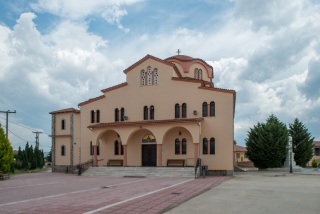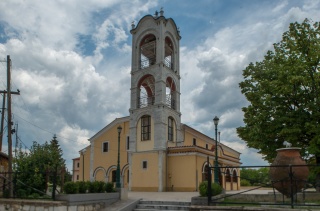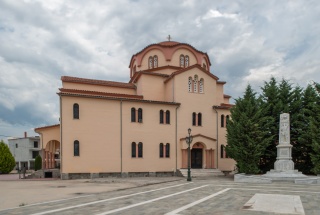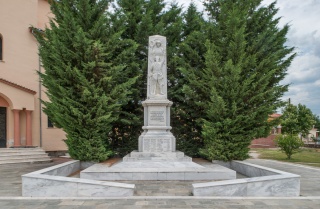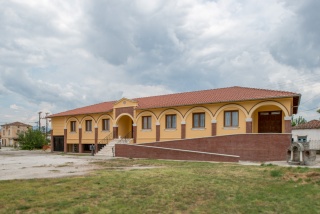Traveler's Guide
East Macedonia & Thrace
Holy Church of Saint Athanasius-Doxato

A remarkable building in Doksato is the church of Saint Athanasius in the center of the village which was built in 1867, with the support and expense of all the Christians of Doxato. The order of the building is simple basilica because the Ottoman occupiers of the time did not want to build domed churches so as not to look like minarets that had domes. Its external part seemed like a warehouse so as not to challenge the Turks, in who Doxato were then enslaved. The windows were built high enough not being possible for someone to look inside. It replaced the previous Parish church, which was also dedicated to Saint Athanasius, and was in the position of the current cemetery. Local folklore mentions the phrase that old people from Doxato used to say: "At the end we all go to Saint Athanasius," with which they humorously talk about the fact of the funeral sequence that simultaneously proving the existence of the church in this particular location. The entrance of the church was built with a peristyle below the walled plate that still exists on the west side of the church and ruled the outer narthex. Later, a narthex was built to enlarge the space of the church and changed the entry that exists today. The entrance was open only on Sundays. Internally, it has three aisles and a the women"s loft. It is supported on columns that are made of tree trunks coated with lime mortar and straw. In the upper part there are pillars of Corinthian order. The roof is wooden and there is a hagiography of God. The floor is marbled and the center of it was a raised bicep eagle who is now hardly visible. The handmade carved wooden icon screen is exceptionally beautiful and it is based on tree trunks who remained unabridged, and uncoated due to lack of financial resources. For the same reason the upper part of the iconostasis is not carved, too (work of Epirus" workmen). It is decorated with images of 1870, which are donations of the old families of Doxato and Choristi. It is equivalent to the old church of the Metropolis, of Eikosifoinissa and Choristi. The Holy Table, the Prelaticat throne, the pulpit and the Icon stand are also handmade woodcrafts. Historical sources indicate that the candles are of Austrian manufacture and origin. In the courtyard there was a platform with a canopy for perpetrating celebrations. At the back of the temple at that time there was a boys "school and a girls" school. The belfry was built in 1893, is marbled and previously existed in this watch, which was destroyed by natural disasters. It is one of the most beautiful in the area, a true work of art. On the fourth floor there are two bells. As for the height of the belfry there have been noted some objections by the Ottoman conquerors. This happened because the Turks did not like the Orthodox belfry to surpass in height the Ottoman minaret that was in the place that nowadays the City Hall of Doxato is housed. The final solution that was given was to be at the same height. Furthermore, the people of Doxato raised the floor of the area around the temple in order to get the belfry higher. In the destruction in 1913 the temple suffered minor damage from the fire. This year also took place the change of direction of the main entrance of the church from west, to southwest, which remains like this until today. By ministerial decision, the church has been declared . Over the years, the church have been a focal point for locals for perpetrating various sacraments, and so there have been the need of its restoration. The restoration of the church was taken over by the priest Mr. Angelos Ioannis with its committee during the period from 1997 to 2005. The restoration began in the tile roof and expanded inside the temple. The walls were painted, the initial color of the icon screen of the 1870s was discovered and restored (the green color around images), the belfry was cleaned and cornerstones were revealed under the plate of inauguration. The cornerstones were placed on the west side and were cemented in the past. The eagerness of the priest of that period, in which some of the information of this work is dased on, encouraged him to collect items like silver vigil candles and crystal chandeliers that are either in the cemeteries of Doxato or in the warehouse of the church of that time (1870). In the context of restoration, of all these items were carefully preserved and placed back in their initial place where can be seen by visitor, nowdays. This particular church is open to visitors until today and performs worships on small celebrations, Saturdays and some Sundays, especially in the winter, and night vigils take place inside it.
Management Body: Holy Metropolis of Drama
Tel. +302521032362
Chaplains: Konstantinos Vassiliadis, George Fyrinidis
Address
No information available.Contact Information
+302521066098
